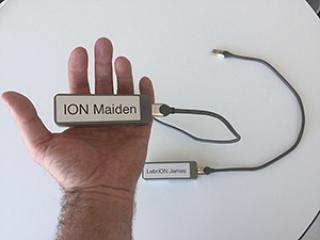
Aaron Quinlan, PhD, associate professor of Human Genetics and Biomedical Informatics at University of Utah Health, and Tom Sasani, a graduate student in Quinlan’s lab, are using the Oxford Nanopore MinION, a new genome sequencing tool to explore the human genome to understand and diagnose disease.
Sasani set the MinION, labeled LebrION James, on the table. “We have another one downstairs that we call the ION Maiden,” he said. “But it is running a sample.”
Reminiscent of futuristic technology from Star Trek, the MinION, no larger than a harmonica, enables the researchers to sequence DNA and RNA in the lab or the field in real-time following only simple sample preparation.
“You could take it out into the field and analyze the critters living in the mucky pond water,” said Quinlan. “You can also use it for really long genome reads, like for the human genome.”
Stretched end-to-end, the human genome extends six-feet. It is highly variable in structure and is littered with thousands of duplications and deletions. While these variations are difficult to annotate with other genome sequencers, it is a piece of cake for the MinION.
“Think of the human genome like a copy of Moby Dick,” explained Quinlan. “Every person has basically the same book, but some people have a copy with two chapter 7s, while another person has a copy where the third paragraph on the fourth page is missing.”
These structurally plastic regions of the human genome are associated with specific disorders that have been difficult to impossible to characterize.
“The beauty of this technology is that we can use these long reads [from the MinION] to characterize the variation in the loci with respect to human disease,” Quinlan said.
As an investigator at the USTAR Center for Genetic Discovery, Quinlan sees endless opportunities to use this new tool to analyze and explore genomes, especially in part with the Utah Genome Project, to understand and diagnose disease better.
From Long to Short Reads
The human genome is about three billion base pairs, but the genome of the virus vaccinia is only 200,000 bases. Though slight in stature, the genome is just as compelling to Quinlan and Sasani.
“When you think about evolution, you think it happens slowly, but that isn’t always the case,” said Quinlan.
Sasani is using these small devices to understand how viruses outsmart the host cells that they infect. He is building on the work that began in Nels Elde’s lab at U of U Health. Vaccinia is a mild poxvirus for humans that was commonly given as a live-virus vaccine against smallpox.
Viruses reproduce by hijacking the machinery of the host cell. In humans, the cell responds to the viral infection by preventing the virus from replicating. Not every cell is successful.
To find out why, Elde’s team removed a gene in the vaccinia genome that made it more difficult to infect a human cell. Then, they artificially forced the virus to evolve.
“After inserting the virus into human cells in the lab, they watched how it adapted,” said Sasani.
Through this preliminary work, Elde’s team confirmed that the virus was duplicating a key gene driving host resistance in its genome. During each step in its evolution, some viruses were also picking up single nucleotide changes in the copies of this gene. Through this process, the virus compensated for the section of the genome that had been removed. And it happened rapidly.
“By 10 passes, the virus contained the nucleotide [in the gene] that was originally removed and could defeat the host cell response again,” said Sasani.
Putting LebrION James and ION Maiden to work, Sasani and Kelsey Cone, a postdoctoral scientist in the Elde lab, repeated Elde’s work, but at each stage in the evolutionary process, they sequenced the viral genome.
“It is pretty amazing,” said Quinlan. “This technology allows us to unambiguously characterize each individual viral genome as it evolves.”
Using the MinION, Sasani can determine how many copies of a section of the genome was duplicated and identify any other genetic changes that took place in the virus to combat the host.
“One 48-hour sequencing run is enough to characterize a population of viruses,” said Sasani. “Smaller organisms, like vaccinia, only need one or two runs to characterize the entire genome.”
The purified viral DNA sample is injected into the MinION, where the DNA double helix is unwound and half of the strand is transported through one of 2,048 pores aligned into 512 nanochannels in the device simultaneously. As the DNA strand moves through the pore channel, each individual base—adenine, cytosine, guanine, and thymine—disrupts the electrical signal, like Morse code. This signal is transmitted as raw data to the attached laptop. A computer algorithm translates the Morse code electrical signal to reproduce the genome sequence.
Sasani’s research can expand on understanding the process of how a virus expands its genome and picks up single nucleotide changes as it evolves to combat a cell’s defense system. Such knowledge could be used to discover new ways to block viruses from spreading infectious diseases.
“When I started out, I never would have imagined technology like this would have existed,” said Quinlan. “It democratizes science for small- or medium-sized labs, because you don’t need a genome center or to buy large, expensive equipment to explore an organism’s genome.”
